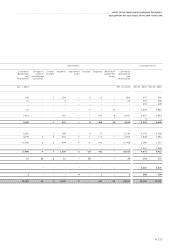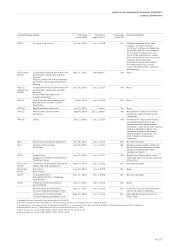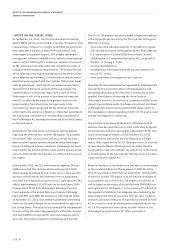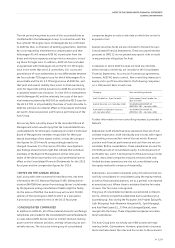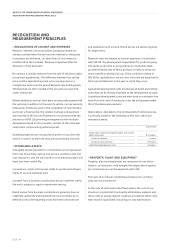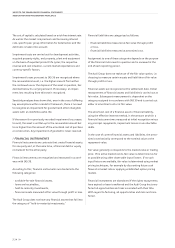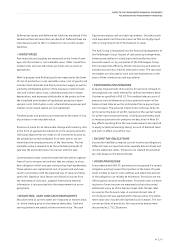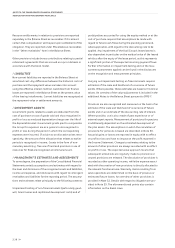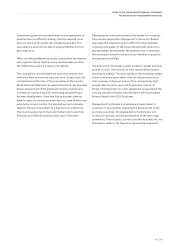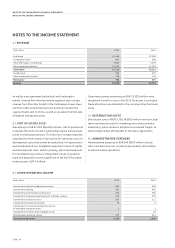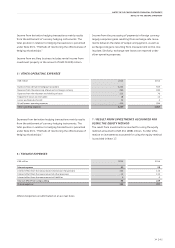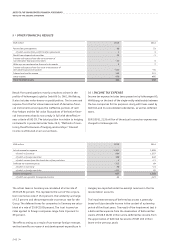Audi 2015 Annual Report Download - page 234
Download and view the complete annual report
Please find page 234 of the 2015 Audi annual report below. You can navigate through the pages in the report by either clicking on the pages listed below, or by using the keyword search tool below to find specific information within the annual report.
NOTES TO THE CONSOLIDATED FINANCIAL STATEMENTS
RECOGNITION AND MEASUREMENT PRINCIPLES
234 >>
The cost of capital is calculated based on a risk-free interest rate.
As well as the market risk premium and borrowing interest
rate, specific peer group information for beta factors and the
debt ratio is taken into account.
Impairment tests are carried out for development activities,
acquired property rights, and property, plant and equipment
on the basis of expected product life cycles, the respective
revenue and cost situation, current market expectations and
currency-specific factors.
Impairment losses pursuant to IAS 36 are recognized where
the recoverable amount, i.e. the higher amount from either
the continued use or the disposal of the asset in question, has
declined below its carrying amount. If necessary, an impair-
ment loss resulting from this test is recognized.
Sensitivity analyses have shown that, even in the case of differing
key assumptions within a realistic framework, there is no need
to recognize an impairment for goodwill and other intangible
assets with an indefinite useful life.
If the reason for a previously recorded impairment loss ceases
to exist, the asset is written up to the recoverable amount but
to no higher than the amount of the amortized cost of purchase
or construction. Any impairment of goodwill is never reversed.
/FINANCIAL INSTRUMENTS
Financial instruments are contracts that create financial assets
for one party and, at the same time, a financial debt or equity
instrument for the other party.
Financial instruments are recognized and measured in accord-
ance with IAS 39.
According to this, financial instruments are divided into the
following categories:
>available-for-sale financial assets,
>loans and receivables,
>held-to-maturity investments,
>financial assets measured at fair value through profit or loss.
The Audi Group does not have any financial assets that fall into
the category of “held-to-maturity investments.”
Financial liabilities are categorized as follows:
>financial liabilities measured at fair value through profit
or loss,
>financial liabilities measured at amortized cost.
Assignment to one of these categories depends on the purpose
of the financial instrument in question and is reviewed at the
end of each reporting period.
The Audi Group does not make use of the fair value option, i.e.
choosing to measure certain assets and liabilities at fair value
through profit or loss.
Financial assets are recognized on the settlement date. Initial
measurement of financial assets and liabilities is carried out at
fair value. Subsequent measurement is dependent on the
category assigned in accordance with IAS 39 and is carried out
either at amortized cost or at fair value.
The amortized cost of a financial asset or financial liability,
using the effective interest method, is the amount at which a
financial instrument was measured at initial recognition minus
any principal repayments, impairment losses or uncollectable
debts.
In the case of current financial assets and liabilities, the amor-
tized costs basically correspond to the nominal value or the
repayment value.
Fair value generally corresponds to the market value or trading
price. If no active market exists, fair value is determined as far
as possible using other observable input factors. If no such
input factors are available, fair value is determined using market
pricing techniques, for example by discounting future cash
flows at a market rate or applying established option pricing
models.
Financial instruments are abandoned if the rights to payments
have expired or been transferred and the Audi Group has trans-
ferred all opportunities and risks associated with their title.
With regard to factoring, all opportunities and risks are trans-
ferred.



